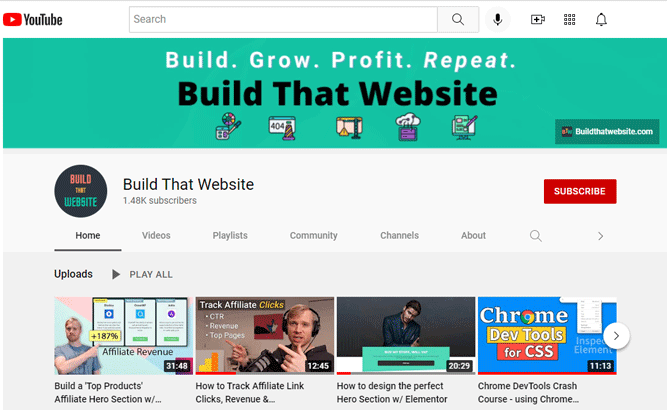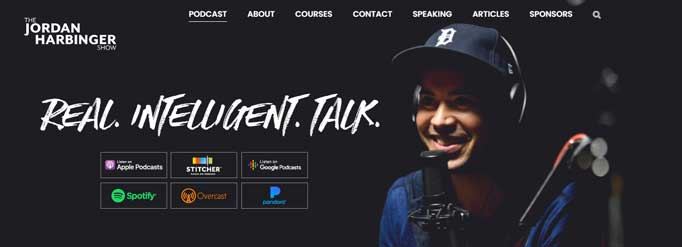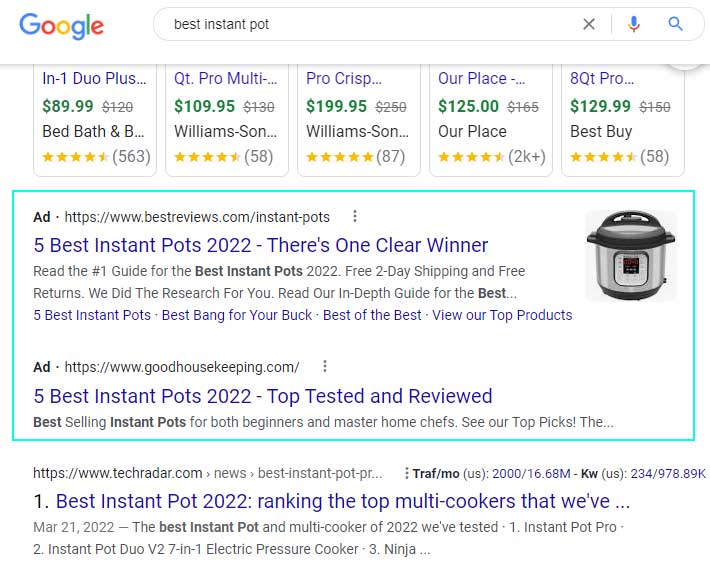You might not realize it, but that fast majority of affiliate marketing is done anonymously. In fact, billions of dollars are earned by affiliate marketers annually without ever showing their face.
You don’t have to be an influencer or thought leader like Pat Flynn, John Chow, or Ryan Deiss to make a living with affiliate marketing.
It’s completely possible to build a six-figure affiliate income without any of your customers seeing your face or knowing your name.
I know, I’ve done it.
For the first 9 years of my online-business journey, I operated in the background, building up a profitable portfolio of content-first affiliate sites. But I’ve also earned affiliate income anonymously on social platforms like Twitter (just a little) or Youtube (quite a lot).
Here are some of the best ways to start affiliate marketing without showing your face:
- Start a blog or website
- Social Media
- Start a YouTube channel
- Podcasting
- Build an email list
- PPC Marketing
1. Start a Blog / Website
The vast majority of successful affiliate marketers got their start by blogging or building niche websites. Not only is this one of the most profitable ways to make money online, but it also has an incredibly high success rate and a low cost of failure.
That’s probably why it’s the most popular method for faceless affiliate marketing.
You can build a WordPress affiliate website for less than $50 per year, and if you focus on organic traffic strategy like Google Search traffic, you might have no costs or overhead other than your time.
This is how I got my start with affiliate marketing, and I was able to grow a six-figure affiliate marketing business in 3 years with less than $200 in annual expenses in those early years.
Blogging Anonymously
You don’t have to blog or build websites using your own name. For every Harsh Agrawal or Pat Flynn there are dozens of affiliates building insanely profitable niche websites under pseudonyms or by completely outsourcing the content and using the authors’ names instead.
My first 5 niche websites were built using pseudonyms or brand names. You can even skip author names altogether and build your WordPress sites using Pages instead of Posts. Google doesn’t care. They just want good content.
Faceless Niche Website Examples
Here are some examples of affiliate websites that are being built anonymously or pseudonymously. Some of them are comfortably earning six-figures (or more) per year.
- Outdoor Gear Lab (7-figures, outsourced content)
- Gadget Review (6+ figures, outsourced)
- Pet Keen (7 figures, outsourced)
- Financial Samurai – Pseudonymous
- Gear Rank – Pseudonymous
- Flow Racers – Branded, pseudonymous
Crafting your anonymous identity
Blogging anonymously is quite easy. There are a couple different ways to pull it off.
Be the brand
Instead of blogging under your name (or any name) just use your brand name as the other name. For example, Flow Racers (above) is both the site name and author name for every article. Plenty of other sites use the same method (including some one of my own sites).
Invent a digital identity

In the age of AI, you can have a face without borrowing someone else’s. Tools like thispersondoesnotexist (example above) will generate completely unique headshots using AI.
Lots of affiliate sites are using TPDNE (and similar tools) to build virtual avatars for their sites. This allows the owners to create content pseudonymously while still having the trust and credibility of a ‘real’ person in the author box.
It’s also useful for creating multiple author profiles, for a single pseudonymous author. Once you start looking, you’ll see these AI faces everywhere around the web (you can usually spot them by their blurry backgrounds, subtle imperfections and exactly centered faces).
It’s easier to generate real-looking male faces. Females frequently suffer from mismatched earnings (as in the photo above).
2. Social Media
There are thousands of social influencers making a six-figure income while remaining anonymous. Though this is harder on visual-first social media platforms like Instagram, it’s quite easy to pull off on Twitter.
In fact, anonymous profiles outnumber real ones on twitter, which means its not an uphill battle to grow a following without showing your face.
Examples of anonymous influencer accounts
Here are a few anonymous twitter accounts that have grown (and monetized) large followings, many in a relatively short time period:
- Wiz of Ecom (E-Commerce) | @wizofecom
- Millennial Money Woman (Money) | @The_MMW
- The Long View (Finance/Stocks) | @HayekAndKeynes
I even did a proof of concept twitter account, to see if I could earn affiliate income tweeting out hard-to-find items during the early days of the pandemic. I earned about $15 from less than 50 tweets.
The plan was to automate it using Amazon’s API, but I decided to focus my energies on this website instead.
Monetization Strategies
Social media accounts are pretty easy to monetize, and you’ll see these three strategies used most often:
- Affiliate Offers: Direct affiliate offers, usually mixed into high-value content like detailed threads. They can also be combined with a coupon/sale.
- Premium Subscription: Join my membership/email list/patreon
- Own Products: Courses, e-books, tools
3. Youtube

Even though Youtube is a video platform, it’s actually perfect for people who don’t want to show their face. There are multiple video formats that can be both successful and highly lucrative, without appearing on camera.
In fact, I have two small, anonymous Youtube Channels that combine for five-figures in annual affiliate income. In fact, Youtube is perfect for affiliate marketing.
Creating YouTube videos anonymously
There are several ways to create Youtube videos anonymously. The most obvious (and most expensive) is to simply outsource the content and hire on-screen talent. For example, one of my competitors (Create a Pro Website) is doing this at a high level, and quite profitably.
But there are plenty of low-budget methods too:
- Screencasting: instead of filming with a video camera, you can record your screen. This is great for software tutorials and walkthroughs, or anything related to computers. In fact, my Youtube channel could be completely faceless if I wanted.
- Voiceovers: You can narrate a Youtube video while filming a scene that doesn’t show your face. A simple example would be a product review or unboxing video.
- Mashups: You can easily create ’roundup’ videos, featuring lists of products, tips, facts or anything else you can think of. Each segment of the video is just 10-30 seconds. You can use your own footage, stock footage, or 3rd-party footage as long as you stay within the bounds of fair use.
Monetizing YouTube Videos
There are plenty of ways to monetize your Youtube videos. The default method is Google Adsense which is available once you hit 1,000 subscribers and 4,000 hours of watch time. It won’t make you rich, but it’s still worth $2-10/1000 views.
A more profitable option is to integrate affiliate offers into your videos. The best way to do this is by using a tool or product in the video as a solution to a problem your viewer faces. Or you can just do the obvious thing and make a review/how-to video.
Then just add your affiliate link to the video description. Even better, create a custom cloaked affiliate link for your product and mention it in the video.
4. Podcasting

Podcasting is an effective platform for affiliate marketing and one where you’ll never have to show your face (audio only). And of course you can choose to run your podcast anonymously or pseudonymously if you wish.
Hundreds of podcasters have cracked the 7-figure mark with monetization strategies that include affiliate promotions.
Successful podcasters who make with affiliate products include:
- Joe Rogan
- Pat Flynn
- Jordan Harbinger
- Gary Vaynerchuck
Granted, all the people on this list above are ‘influencers’ who use their own name and face for their podcast. But that’s a choice, and you can choose to stay in the shadows if you want to. There are plenty of podcasters who do the same, either for privacy, or even personal safety (such as exposing corruption or crime).
All you need to get started with your podcast is a decent USB microphone and an idea. You can easily record and edit using free software like Audacity, GarageBand (mac only) or Cakewalk.
5. Grow an Email List
Email Marketing is one of the most popular options for faceless affiliate marketers, and battle-tested marketing channel that has stood the test of time.
You don’t even need a website to get started. All you need is some way to drive traffic to your signup page. I have dozens of examples of pseudonymous creators building six-figure businesses just with email.
You can start your own email list for free (up to 1000 subscribers) using ConvertKit.
How email marketing works
Building a profitable email marketing strategy requires four things
- Traffic source (how you drive subscribers)
- Landing Page
- Value proposition (why should people sign up)
- Monetization strategy
Traffic Source (how you get subscribers)
Because email does require a traffic source, you’ll usually combine email marketing with one of the other traffic sources mentioned in this article (website, Youtube, social, PPC).
It can be as simple as putting a link to your email subscription form in your social profile (e.g. Twitter) and mentioning your email list once in a while.
Landing Page
You’ll need an opt-in form or landing page. This is where you’ll send your traffic to subscribe to your list. A good landing page is pretty simple, and contains a few elements:
- A signup form (usually just an email address field, with optional first name)
- Headline
- Offer / Value proposition (why someone should subscribe)
Value Proposition
What is the subscriber going to get in exchange for their email address? After all, no one is going to sign up just to get marketed to. So what’s your offer.
Most email marketers rely on one (or both) of the following:
- Value-driven content: subscriber only insights and relevant content delivered to their inbox
- A Bribe: Known as a ‘lead-magnet’ in the industry, this ethical bribe is a high-value freebie you give away in exchange for an opt-in. It could be a cheatsheat, white paper, free template, e-book or anything else that’s relevant and valuable to your audience.
Monetization
One you’ve got a sustainable lead generation strategy for your email list, it’s time to start making money. There are a couple ways to do it.
- Affiliate Offers: Mix in relevant affiliate offers with your content. For example, an email could talk about a problem your audience faces, and the product is the best solution.
- Premium Subscription: You can sell an upgraded version of your free newsletter using a subscription model. The pro version has deeper insights or more frequent content. You see a ton of this in the financial, real estate, and crypto space.
- Digital Products: Sell your own e-books, templates or other high-margin digital products to really rake in the cash.
6. Pay-Per-Click Marketing (PPC)

PPC marketing is the big leagues of affiliate marketing. It’s where heavy hitters you’ve never heard of are making 7, 8, even 9 figures annually.
Sites Bestreviews.com get most of their traffic from paid search, and they’re caching in to the (estimated) tune of mid-six figures monthly.
Anyone can start affiliate marketing with paid traffic and it’s incredibly easy to do anonymously. All you need is a simple website or landing page and a list of relevant keywords to bid on.
Of course it’s not that easy. You’re competing against some of the most talented, experiences and sometimes ruthless marketers in the business, all competing in a zero-sum game to squeeze every last drop of revenue from the paid search positions.
It’s not for the faint of heart, but if you find a system or offer than works you can quickly scale from $10/day to $1,000/day or more. All you need is an profitable campaign and Google (or other paid traffic source) will do the rest.
Just make sure to consistently tweak, test and fine-tune your ad copy and landing pages, to keep your campaigns in profit.
Benefits of Paid Traffic
Even though the success rate is much lower than alternatives like blogging, PPC has several advantages.
First, you’re getting targeted traffic at the bottom of the sales funnel. People ready to buy. This means that your conversion rate and revenue per visitor will be much higher than organic traffic.
Secondly, you can start generating traffic immediately. You don’t need to publish content for months or wait out the Google Sandbox to get traffic. With PPC you can send traffic to your affiliate offers from day 1.
Pros & Cons of Anonymity
It’s perfectly possible to build a six-figure (or higher) income with anonymous affiliate marketing. But there are tradeoffs that come with privacy.
Let’s look at some of the common downsides of operating anonymously. These factors are (at least partially) why I elected to put my face and name on my latest project.
Advantages of Anonymous Affiliate Marketing
Disadvantages of Anonymity
Another downside that’s more specific to websites/blogs is your ability to earn high-quality backlinks. White-hat link building is much easier if you’re a real person and you can make real connections with other people or websites in your industry.
Your choice isn’t permanent
Just because you start your affiliate marketing business without showing your face doesn’t mean it has to stay that way forever.
With proper planning, you can step forward and claim your clout whenever you’re ready. So don’t feel pressure to choose up front. That’s why most people start affiliate marketing anonymously, and consider going public with their business once it’s successful.
Which offers to promote?
These days, the vast majority of online brands have some form of affiliate or referral program. Affiliate marketing is a win/win for both the brand and affiliates, because it lets them outsource sales effectively while securing tons of brand mentions (mostly positive) from their affiliate partners.
Most novice affiliates start with popular programs like Amazon Associates, which lets you sell almost any physical product imaginable.
As you gain experience, however, you should be open to other affiliate networks and one-off affiliate programs, which are often the most lucrative.
Especially profitable are programs with recurring commissions. These are often high-margin software and SaaS companies, which pay you for the life of the subscribers you refer. These are the kind of offers that lifted my business past the six-figure mark and are one of the best ways to build truly passive income. I’m still getting paid for sales I made 5 years ago.
Additional Tips
Here are a few more tips to increase your chances of success:
- Test. Don’t stick with one offer, method, or affiliate marketing system. Be willing to try and test new things until you find one that works.
- Be Ethical. Don’t just promote affiliate offers that pay the highest. You should be promoting affiliate products that get results for your audience, not just your bank account. In the long run this will earn you more trust and more sales. This game is about longevity, not quick profits.
- Be Patient. There few overnight successes in this business. Most of the truly successful affiliates took years to learn the ropes and grow their business. If you have realistic expectations, you’re more likely to stick with it through the challenging early days.

